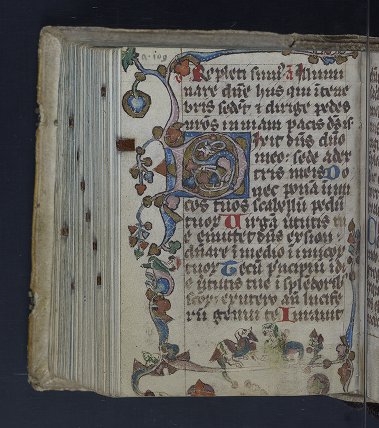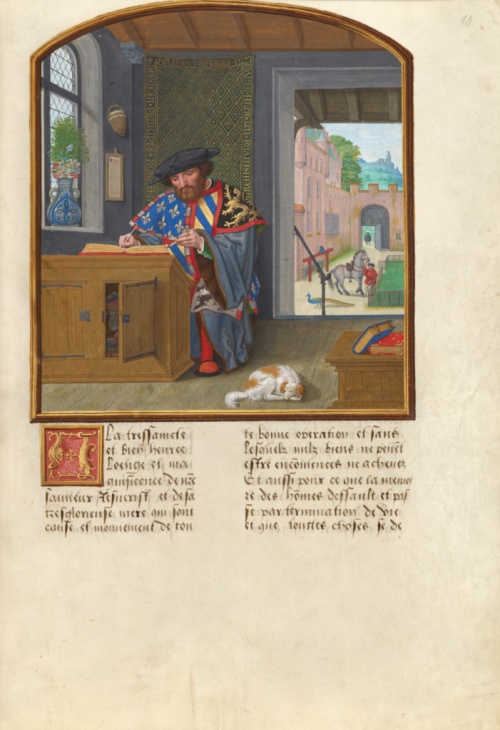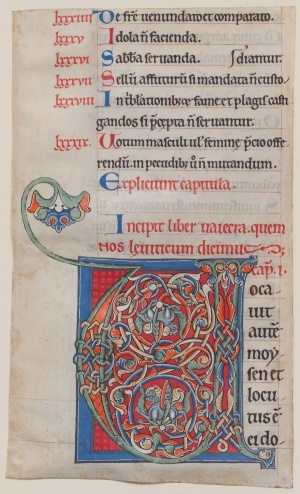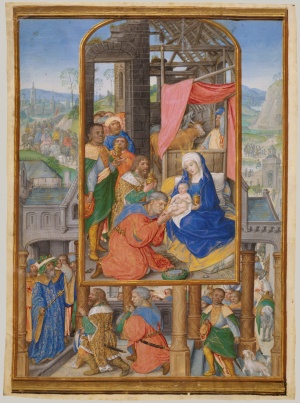Illumination
In the study of illumination, there are differing opinions on what is considered to be an illuminated manuscript. Generally, they are manuscripts decorated with gold or silver, brilliant colors, and elaborate designs of miniature pictures, initials, and other details on the margins or borders on the parchment. However, in strictest terms, only manuscripts with gold and silver can be labeled as illuminated. [1] For the purposes of this essay, I will be referring to this definition. For these manuscripts, illumination was a strategic way to mark the importance of a certain section of the text. It created different levels of priority amongst readers. Illumination was not just for decorative purposes, but keys in which to approach a text. But as time progressed, the issue was no longer navigating the text amongst the words themselves, but instead negotiating attention between the illustration and the text.
Generally, it should be noted that silver was less common than gold because it was subject to tarnishing. A substitute for silver was tin, which was less expensive and did not oxidize as fast. For gold, there were two types used, shell gold and gold leaf. A substitute for gold was also mosaic gold. This was a tin disulfide mixture that could be used like paint which resulted in a pigment that was gold in color, but had a grainy surface once applied to the page. [2] Regardless of which material was used and or even the size of illustration itself, illumination served as a connection between text and art. Although illumination was present in Middle Eastern societies, Europe is where we find the most highly developed techniques of this process, especially from France or the Netherlands. [3]
Background Information
Illuminated manuscripts were thought to have been made exclusively by monks in monasteries, beginning around the 3rd or 5th century. However, entering into the 12th century, there was now an emerging coordination between these monks and private urban book sellers which created a spike in production and sales. It is unclear whether the monks sought out the book sellers, or vice versa. But what is clear was that there was a collaboration. During the 12th century, especially in Europe, it was thought that monks, scholars, and aristocrats were starting to become interesting in classifying and ordering knowledge. This is evident by the encyclopedias and catalogues that monks were creating during this time. [4] Part of this classification was also creating easier accessibility to knowledge, which meant not only accessing it from other places, but also most easily within the manuscript itself. Illumination was a way to point to the most significant information in the text. Because of a lack of page number and other guiding forms of structure, information required another mechanism to show the hierarchy of information. Illumination drew the eye to that section of text, and helped distinguish sections of texts from others that had none.
Illumination in Manuscripts
At first, designs were limited to simple initials or isolated linear patterns found on the margins. Examples of this kind of design are found in a fantastic 14th century ferial psalter from Italy. Although this psalter was constructed during a time when illustrations featuring figures and landscapes were becoming popular, the text contains marginal designs and detailed initials that would have been akin to those made in earlier centuries. In this case, there are eight sections that divide the psalm. Those divisions are marked by illuminated marginal designs. As seen on page 16 from the psalter, the designs are confined to the border. While decorative, it is also a signifier for the reader to know it is the the start of a different section of the text. The illustrations are not a figure or object mentioned in the content. Instead, we see decorative plants and animals which would not have had much specific significance to the psalter, nor were they referencing anything. They were designs that could be easily manufactured and repeated in other copies of this psalter. This meant that readers would appreciate the placement of the designs as a navigational tools, but their reading of the text did not rely on the designs themselves to elaborate on the words.

The type of gold featured in this psalter is gold leaf. Gold leaf was gold that had to be beaten with a hammer and anvil till extreme thinness was reached. Therefore, this method was extremely costly not only because of the gold itself, but because of the metalworkers’ fee. Applying this gold leaf was very labor intensive. Gold leaf had to be applied before the rest of materials used in the illustration. This is because the leaf would stick to the pigments already on the page, and the burnishing of the gold which followed the application would damage any illustration. In the case of this psalter then, where to place the gold had to be mapped out with a light sketch along with the rest of illustration to be later done. Before the leaf was applied, artists had to lay down a base that the gold would stick to, such as egg white. For a base, artists and monks also favored gesso, a plaster of lead white and sugar colored pink or brown because of a clay ingredient. This colored gesso helped artists see where to exactly lay down the leaf, a method useful to have if the illuminator was still learning their trade. After the gesso dried in place, the artist would breath on it to make it tacky so the leaf would stick and adhere to the page. The leaf was then burnished with a stone or animal tooth to rub away excess gold and polish it. [5]
During the 14th century when this psalter was created, techniques would have allowed large sections applied with gold, but instead this psalter features small shapes of gold. This may have been due to a limit in budget or materials when preparing this manuscript, but it may also have had to do with the ability of the illuminator. If they weren't as skilled or as practiced in illumination as they were with illustration, they may have stuck to simple shapes rather than complex figures. For simple shapes featured on page 183, a colored gesso would have been highly advantageous to use. The designs featured on these margins are not delicate, although it would have taken a delicate hand to lay down the gold. The illuminator was not shaping the gold leaf in sharp points or tiny ridges. Instead the shapes are quite rough which may indicate the experience, or lack thereof, of either the illustrator or illuminator. Because the dimensions of this psalter are so small (only 116 x 75 mm), large illustrations and uses of gold would not have fit along with the text. They did not have much room to be creative in their art. However, overtime marginal patterns and decorative initials, such as the ones found in this psalter, eventually transformed into highly detailed miniatures of figures and landscapes. This evolution of illumination had a variety of factors, such as materials with shifting availabilities and new techniques emerging and developing. This changing landscape of the process allowed illuminators to expand out from the constraints of the margin and into illustrations that are more similar to what we see in books today which often fill the page.

Because this is a fairly late example of an illuminated text, it was quite possible that this psalter was owned by an aristocrat for private prayer, rather than be part of a monastery’s private library. Its small size also speaks to its portability, meaning it may have traveled with the owner. The fact that this manuscript is still in exquisite shape speaks to how it was delicately treated. While this manuscript was perhaps illuminated by a monk, there is also another possibility. Because monks were anxious to own these illuminated manuscripts, they could no longer keep up with production for their private collections and commissioned works. In fact, because of an increase in buyers from the elite class, this created competition between monasteries and aristocrats for illuminated texts. Because of this rise in production, Europe saw an expansion of artists who did illumination outside of monasteries. [6] However, there still is a question on whether or not these illuminators sought out work from the monks or if they were hired. Because of the late dating on this psalter we are examining, there is more suspicion cast on whether a monk or a private artist did the illumination. Regardless of who did the illumination, this psalter features wonderful examples of gold leaf featured in simple designs and initials.
Illumination in manuscripts continued into as late as the 16th century when popularity for printing books and illustrations took over as the preferred method. However, during this later period from the 12th to 16th centuries, there was a major shift in genre which occurred alongside changes in production and readership. Manuscripts were evolving outside the parameters set by the religious texts that had once held a monopoly on manuscripts. Illuminated texts now included an expanse of genre: history, mythology, music sheets, allegorical narratives, medical treatises, calendars, and even legal documents. [7] Regardless of time period, illuminated manuscripts were very expensive because of the price of labor and material. Therefore, readership tended to be confined to the monks who made the manuscripts and the elite members of society who could afford to commission and purchase the works. What created this spike in production of illuminated texts was the status these works brought to their owners. More and more of the elite class wanted these symbols of affluence and luxury. Owning a manuscript during this time was notable, but having one with illumination was impressive. Despite the rise of printed books later on, illuminated manuscripts were still very popular among aristocrats. They were highly prized and sought after.
One such case of a secular illuminated text, is a manuscript titled Livre des faits de Jacques de Lalaing. Created in Belgium in 1530, this Flemish manuscript tells the life of Jacques de Lalaing, a famous knight and tournament fighter from the Middle ages. Produced nearly 80 years after his death, this manuscript was commissioned by a member of the Lalaing family hoping to immortalize and continue the fame of Jacques. [8] There were many uses for a secular text, but in this case, this would have been for the family’s private library, or perhaps prominently featured on display in a more public area in the home. The audience was not just those who would commission and own these manuscripts, but other members of the elite class who may see the manuscripts on display. This work of displaying illuminated manuscripts contributed to their rising popularity. This process of commissioning a manuscript illustrated how the readers of the time were looking for specific stories to be told and remembered that were not religious in nature and therefore would not have been a priority to save amongst the general public. Their priorities were changing. It wasn't a matter of purchasing a manuscript where the words had just been copied, but instead they wanted to own something unique. They were a presentation of wealth, not necessarily because of the materiality, but because of the connotations attached to the content. Illumination added not only beauty to a text. Now, it attached status and prestige not only to the owner, but to the words of the manuscript. For secular texts, illumination offered legitimacy that would have only been extended to religious works.

The artist for this specific manuscript was Simon Bening, one of the greatest masters of illumination who worked for powerful aristocrats and international royal patrons. [9] Bening learned his craft in the workshop from his father. When studying illuminated manuscripts in contemporary times, it is nearly impossible to know the exact ingredients of the illustrations without chemical analysis, which is often a highly invasive technique. While there are surviving manuscripts and treatises that have recipes for pigments and explanations of methods used in illumination, historians can only take these records at face value. Often painters guarded recipes and techniques and only passed them down through apprenticeship. [10] Therefore, Bening learning from his father was not an uncommon phenomenon. This was no longer an anonymous monk illuminating a text, but instead a well known artist, which in itself attached a certain prestige of its own. The families who had these manuscripts commissioned no longer had to operate within the confines of religion that monks may have insisted upon. As we neared the 16th century, aristocrats were dealing with private and famous artists directly.
As for the illustrations in this manuscript, they are highly different from the horizontal and vertical patterns we looked at previously which had remained on the margins. In the illustration from this manuscript, we see a detailed and complex image of Jacques in full armor and a background image of a tent. Unlike our earlier example, this manuscript employs the other type of gold used in illumination: gold shell. This was powdered gold mixed with gum in a shell. This mixture was then applied with a pen or brush only after the colors of the illustration had been laid down. Applying this gold with a brush allowed for delicate and thin details that gold leaf could just not achieve. Because of this, shell gold was mainly used for highlights rather than blocked out areas. In religious texts, gold shell would often be applied onto illustrations of religious figures, especially for the halos. [11] However, in this case, the highlights are found on clothing, weaponry, and background objects of importance. This was all done to highlight not the significance of a religious figure, but the wealth and gallantry of an aristocratic man. Gold was no longer being used in illustrations and patterns to offer directional keys to a reader. Instead, this manuscript demonstrated the wealth and history of a specific family, as well as the exploits of a real figure in history. This was a symbol elite families could show off to others in their class, and that meant being able to glean what was being written about in just a glance, something the designs in the psalter would not have been able to provide its readers. While the designs in the psalter may not have been religious in nature, they couldn't be explicitly secular either. Illumination was a tool artists were using to branch out from religious imagery and into works which may have afforded them more creativity.
Illumination with shell gold also differs from gold leaf in the way it survives time. One of the dangers of gold leaf is that through time it may flake and break off the page. [12] Despite issues with conservation, these illustrations can help us see what the authors and readers thought was important in a text. Looking back, we can see what topics or stories the people living during the time of production (who could afford to have manuscripts commissioned) found crucial to survive for future readers, Simon Bening’s work on the Livre des faits de Jacques de Lalaing is an example of such a text that is from a final period of beautiful Flemish and Italian illumination before illumination tapered out with printing books and illustrations, and the new genre of the portrait miniature. [13]

Because I do not have access to the dimensions of the illumination we have just examined in relation to the text and the page itself, I have provided another page from the manuscript titled The King of Arms of the Order of the Golden Fleece Writing about Jacques de Lalaing. While the miniatures found in this manuscript offer interpretations of crucial moments in Jacques Lalaings’ military exploits and deeds, this large portrait found at the opening of the manuscript is key to this discussion on the evolution of illumination. This image represents a man who is believed to be the author of the manuscript, Jean Le Fèvre de Saint Rémy, in his study working on the manuscript in question. As the title states, Le Fèvre was the King of Arms for the Order of the Golden Fleece, the order in which Lalaing served as a knight. Additionally, Le Fèvre and Lalaing were close friends which may explain why Le Fèvre was chosen to author the manuscript. [14] His high status also points to why the illuminator decided to include him the manuscript. Previously, it would have been religious figures who were given faces, but now it was the author receiving that privilege.
Compared to the psalter we viewed earlier, this illumination dominated the page due to its large size. Not only the size monopolizes the reader’s attention, but the detail given to the illustration. The colors are rich, and the scene is extremely lifelike, even more so than the image of Jacques himself. The intricacies at which the spatial depth is brought to life through shadowing and the landscape is phenomenon. Everything in the scene points to luxury: the extra manuscripts, the clothing, and even a peacock in the background. Compared to this, the short columns of text situated below the miniature is underwhelming. If the illumination was done after the words had been written (which is likely), then Le Fèvre would have deliberately left that space for himself. This tells us that commissioned illuminated manuscripts were not just opportunities for the subject in question to be represented, but the author as well. In this case, the people reading, buying, authoring, and illuminating were all in the same circle of class, or at the very least society. This was not a glorified bookmark, but a deliberately laid out scene with history and individuality attached to it. The man who commissioned the work, the author, and the illuminator were all no longer held by the constraints of adhering to religious texts and figures, nor by the free space in the margins. This meant the illuminators were able to expand not only genre, but artistic style. The authority of which these images took on the page was not only physical, but changed reading methods because it inherently placed the text as inferior due to the large size of the miniatures.
Conclusion
Despite what should have been a harmony between text and illustration in these illuminated manuscripts, increasingly complex and intricate scenes complicated this relationship. Illumination blurred the distinction of what was priority in the text: the illustrations or the words. The gold and silver designs became distractions to the reader because of its inherent luxury and expense. For the ferial psalter, illumination easily presented this hierarchy of text and decoration to the reader without fault. The design was decorative, but did not serve as an interruption of the attention given towards the psalms and hymns. It served a purpose as a reading technique and guidance system. The religious text always had to come first for the reader. However, the Livre des faits de Jacques de Lalaing tells another story. The illustrations may have distracted from the text rather than prioritize amongst other sections, or perhaps erased the need for reading the text at all if the manuscript was simply for display purposes. Because the illustrations dominated the page, the reader’s eye went to them first, instinctually making it a priority (deliberately or not). Manuscripts like the Livre des faits de Jacques de Lalaing could now be viewed as a piece of art because the designs were not generic or simple. This could be from a variety of factors, from the size of the image, or how the elite family who commissioned it displayed this work in their home. Looking at these illuminated texts today, our eye is instantly drawn to the gold, and the same was for those living in the time they were created. Illuminated manuscripts were becoming treasured regardless of their content. The evolution of illumination is a fascinating way to show the evolution of artists, readership, and the shifting desirability of genre in the Middle Ages, but it also created a disjunction between written and visual content.
Other Examples
Licensing
The content in this book is licensed Creative Commons Attribution-NonCommercial-NoDerivatives 4.0 International
Bibliography
“Manuscripts | The J. Paul Getty Museum.” Getty Museum, www.getty.edu/art/manuscripts/.
Britannica, The Editors of Encyclopaedia. “Illuminated Manuscript.” Encyclopædia Britannica, Encyclopædia Britannica, Inc., 30 May 2018, www.britannica.com/art/illuminated-manuscript.
Owen, Peter D. “Painting.” Encyclopædia Britannica, Encyclopædia Britannica, Inc., 22 Mar. 2018, www.britannica.com/art/painting/Forms-of-painting#ref364722.
Jones, Susan. “Manuscript Illumination in Northern Europe.” Metmuseum.org, 2002, www.metmuseum.org/toah/hd/manu/hd_manu.htm.
“Illuminated Manuscript.” Wikipedia, Wikimedia Foundation, 5 Oct. 2018, en.wikipedia.org/wiki/Illuminated_manuscript.
Cambridge University. “Secret Histories of Illuminated Manuscripts: the MINIARE Project.” YouTube, YouTube, 12 Oct. 2012, www.youtube.com/watch?v=YMRvXnB7uJg&t=180s.
gettymuseum. “Making Manuscripts.” YouTube, YouTube, 17 June 2014, www.youtube.com/watch?v=nuNfdHNTv9o.
Hamel, Christopher De. A History of Illuminated Manuscripts. Phaidon Press Limited, 2014.
Clemens, Raymond, and Timothy Graham. Introduction to Manuscript Studies. Cornell University Press, 2007.
“Simon Bening (Flemish, about 1483 - 1561) (Getty Museum).” The J. Paul Getty in Los Angeles,www.getty.edu/art/collection/artists/351/simon-bening-flemish-about-1483-1561/.
“Livre Des Faits De Jacques De Lalaing (Getty Museum).” The J. Paul Getty in Los Angeles, www.getty.edu/art/collection/objects/286914/simon-bening-master-of-the-getty-lalaing-livre-des-faits-de-jacques-de-lalaing-flemish-about-1530/.
“Penn in Hand: Selected Manuscripts.” Medieval & Renaissance Manuscripts Collection: Ms. Codex 1057 - Catholic Church - [Ferial Psalter], dla.library.upenn.edu/dla/medren/detail.html?id=MEDREN_9940876113503681.
“Livre Des Faits Du Bon Chevalier Jacques De Lalaing.” Dr. Jörn Günther, guenther-rarebooks.com/artworks/9430/.
Notes
- ↑ Clemens, Raymond, and Timothy Graham. Introduction to Manuscript Studies. Cornell University Press, 2007.
- ↑ Clemens, Raymond, and Timothy Graham. Introduction to Manuscript Studies. Cornell University Press, 2007.
- ↑ Jones, Susan. “Manuscript Illumination in Northern Europe.” Metmuseum.org, 2002, www.metmuseum.org/toah/hd/manu/hd_manu.htm.
- ↑ Hamel, Christopher De. A History of Illuminated Manuscripts. Phaidon Press Limited, 2014.
- ↑ Clemens, Raymond, and Timothy Graham. Introduction to Manuscript Studies. Cornell University Press, 2007.
- ↑ Hamel, Christopher De. A History of Illuminated Manuscripts. Phaidon Press Limited, 2014.
- ↑ Owen, Peter D. “Painting.” Encyclopædia Britannica, Encyclopædia Britannica, Inc., 22 Mar. 2018, www.britannica.com/art/painting/Forms-of-painting#ref364722.
- ↑ “Livre Des Faits De Jacques De Lalaing (Getty Museum).” The J. Paul Getty in Los Angeles, www.getty.edu/art/collection/objects/286914/simon-bening-master-of-the-getty-lalaing-livre-des-faits-de-jacques-de-lalaing-flemish-about-1530/.
- ↑ “Simon Bening (Flemish, about 1483 - 1561) (Getty Museum).” The J. Paul Getty in Los Angeles,www.getty.edu/art/collection/artists/351/simon-bening-flemish-about-1483-1561/.
- ↑ Clemens, Raymond, and Timothy Graham. Introduction to Manuscript Studies. Cornell University Press, 2007.
- ↑ Clemens, Raymond, and Timothy Graham. Introduction to Manuscript Studies. Cornell University Press, 2007.
- ↑ Cambridge University. “Secret Histories of Illuminated Manuscripts: the MINIARE Project.” YouTube, YouTube, 12 Oct. 2012, www.youtube.com/watch?v=YMRvXnB7uJg&t=180s.
- ↑ Jones, Susan. “Manuscript Illumination in Northern Europe.” Metmuseum.org, 2002, www.metmuseum.org/toah/hd/manu/hd_manu.htm.
- ↑ “Livre Des Faits Du Bon Chevalier Jacques De Lalaing.” Dr. Jörn Günther, guenther-rarebooks.com/artworks/9430/.







